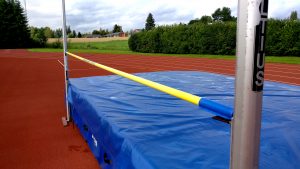Global Youth Conference Track & Field Events
GENERAL GUIDELINES FOR TRACK AND FIELD
- Appropriate athletic clothing must be worn.
- It is the responsibility of the contestant to be present when his event is run. He will be disqualified if he misses his event.
- Substitutions in relay teams are allowed only in cases of sickness or family emergency.
- All substitutions must be approved by the Meet Director.
- Contestants must compete with shoes on both feet.
- In all field events, it is the contestant’s responsibility to check in with the Chief Judge before competition begins.
- Any contestant performing in both field events and running events must immediately report to the starting place for his race when his running event is announced. However, he must tell the field event Chief Judge of his whereabouts and report back to the same judge when his running event is completed; each contestant shall resume field competition where he left off.
- Qualifiers for the final heats will be the eight contestants or teams with the fastest qualifying times. *Twelve (12) contestants qualify for fastest times for the 1600-Meter Run and twelve (12) for the 800-Meter Run.
- A heat shall consist of up to eight runners with each runner assigned his own lane.
- Winners of heats shall be placed in lanes accordingly:
- Fastest Time Lane 4

- Second fastest time Lane 5
- Third fastest time Lane 3
- Fourth fastest time Lane 6
- Fifth fastest time Lane 2
- Sixth fastest time Lane 7
- Seventh fastest time Lane 1
- Eighth fastest time Lane 8
- In the 100-Meter Dash, the 200-Meter Dash, the 400-Meter Dash, the 400-Meter Relay, and the first lap of the 1600-Meter Relay, a runner shall run within his assigned lane and shall not step over his lane line for three or more consecutive steps with either or both feet.
- In the 800-Meter Run, the 1600-Meter Run, and the second lap of the 1600-Meter Relay, a runner must be one full stride ahead of another runner before he can cut over to the latter’s course.
- G.Y.C. Track and Field Records may be set during preliminaries at the G.Y.C. Track Meet.
- All field measurements are to be recorded to the nearest 1/4 inch except in the high jump where the measurements will be recorded, by the judges, to the nearest 1/2 inch. Times are to be recorded to the nearest 1/10 second.
- Starting blocks may be used for any race. It is the responsibility of a fellow teammate to remove the blocks immediately after the race has begun.
- In all events that involve measuring (except high jump), ties by identical measurements shall be separated by the second best performance of the tying contestants. If a tie still exists, it shall be decided by the third performance.
- Spectators and coaches are not allowed on the track field.
- Contestants may wear watches during competition.
TRACK AND FIELD ORDER OF EVENTS
100-Meter Dash
1600-Meter Run
200-Meter Dash
800-MeterRun
400-Meter Relay
1600-Meter Relay
This order is given for your information in selecting your participation in track events.
PERFORMANCE EVENT
- Each relay team must consist of four members.
- Relay runners must be dressed in uniformity; all four runners must be dressed alike.
- Each member must run at least one, and no more than one, leg of the relay.
- A baton must be carried and passed, not thrown, in succession to each runner.
- In each relay, a runner must pass the baton to the next runner inside the 20-meter passing zone. Passing of the baton before the baton reaches the zone or after it goes beyond the zone,disqualifies that team.
- After passing the baton, runners must continue in their lane so as not to interfere with others.
- The baton must be carried by hand.
- If any member of a relay team runs any part of the race without a baton, his team shall be disqualified.
- A dropped baton must be recovered by the runner who dropped it, without interfering with other runners. If a baton is dropped in the passing zone, either runner of the same team in the zone may recover the baton. Disqualification occurs for interfering with another runner.
- A member of a relay team may not run outside the passing zone to take the baton from a fallen member.
- A runner who is to receive the baton may start his running no more than 10 meters outside the 20-meter passing zone. A runner may also start his running anywhere inside the 20-meter passing zone.
- In the 400-Meter Relay, the runners must remain within their lanes throughout the race.
- A 400-Meter Relay team shall consist of 4 runners, each running approximately 100 meters.
- A 1600-Meter Relay team shall consist of 4 runners, each running approximately 400 meters.
- In the 1600-Meter Relay, one lap must be completed before any runner may move to an inside lane. The curve judge of the final leg of the race shall arrange the runners from the inside lane out according to the order of the upcoming runners as they round the curve.
Contestants should select events carefully so they will not be competing in a back-to-back situation; i.e., 400-Meter Relay followed by 1600-Meter Relay.
HIGH-JUMP
- Before competition, each contestant may take one trial jump at the starting height (4’ 6”) for all contestants. Each contestant is allowed three (3) attempts at each height to clear that height. A third failed attempt eliminates the contestant.
- A successful jump is one in which a jumper clears the crossbar without knocking the crossbar off the uprights. An unsuccessful attempt is one in which the contestant knocks the crossbar off with any part of his body or clothing.
- A legal jump is one in which the jumper takes off or jumps from one foot.
- Contestants reporting late will have to begin jumping at the present bar height.
- A high jump crossbar shall be raised two inches at a time until the height of 4’ 10” is reached. From then on, the height shall be raised one inch at a time until six contestants remain. At that point, the height shall be raised one-half inch at a time.
- A contestant may pass at any height. Once he has begun his jumping at any height, he may not pass that height.
- A record of failures and successes shall be marked for all contestants. A zero will stand for a miss, an X will stand for a successful attempt, and a P will stand for a pass. (See example below.)
Example: 5′ 0″ 5′ 2″ 5′ 4″ 5′ 6″
X 0 0 X P 0 0 0
- A try at a height shall be scored when any contestant touches the crossbar, upright supports, or landing area on any official run.
- The winner shall be the person who has made the highest jump. In the case of a tie, the person with the least number of misses shall be declared the winner. If any contestants still remain tied, a jump-off shall occur and be judged again on fewest misses or highest height.
- After all other contestants have failed, the one contestant left has the right to continue jumping until he has three consecutive misses.
RUNNING LONG JUMP
- Each contestant is allowed three jumps.
- Bef
 ore competition starts, each contestant is allowed two practice jumps.
ore competition starts, each contestant is allowed two practice jumps. - A foul jump occurs when the take-off extends past the scratch line. The edge of the take-off board nearest the landing pit shall be the scratch or foul line.
- A foul jump occurs if the contestant touches any area outside the landing pit during his jump or if he runs through or past the pit after having begun his approach.
- Measurements shall be made at right angles to the scratch line from the nearest break in the landing pit made by the contestant’s feet, hands, body, or clothing.
- The landing pit must be raked smooth by an official following each jump.
- All jumps are to be recorded by the Chief Judge.
SHOT-PUT
- Athletic Director will provide the twelve-pound shot.
- Before competition starts, each contestant is allowed two practice puts.
- The contestant with the longest put shall be declared the winner.
- Each contestant is allowed three puts. They are to be taken in succession or in rotation with the other contestants. The contestant may choose one of these two ways.
- A legal put must be made with one hand. During the attempt, the shot must not drop to the shoulder and must be kept in close proximity to the jaw.
- A legal put must land in the designated area. The contestant’s foot must not touch the out of-bounds circle or, if using a stop-board, the top surface area of such stop-board. Any area outside the circle is also illegal until the put has been marked by the officials.
- All puts by each contestant are to be recorded.
- It is not a foul if any part of the contestant swings outside the circle without touching the ground.
- See the National Federation Handbook for Track and Field for the correct way to measure a put.
DISCUS
- Athletic Director will provide the standard size (3 lb. 9 oz. and 8 1/4” to 8 5/16” diameter) rubber discus.
- The contestant is allowed two practice throws.
- The contestant with the longest of three throws will be declared the winner.
- The contestant may not leave the designated throw circle during his event.
- Items 6, 7, 8, and 9 under “Shot-Put” as applicable.
SOCCER KICK
 Soccer Kick competition will be conducted as an elimination event in a similar manner as High Jump.
Soccer Kick competition will be conducted as an elimination event in a similar manner as High Jump.
Rules:
- A standard #5 soccer ball must be used by all contestants. The G.Y.C. Director shall provide a regulation ball and net.
- The ball must be properly inflated and will be checked by the Event Director.
- Athletic shoes without hard toes are required.
- A kicking tee must not be used.
- A successful kick is one that passes into the net without touching the ground. It must be in flight when it passes over the goal line.
- Contestants are permitted two “warm-up” kicks.
- Contestants can take no more than two approach steps.
- Contact with the ball constitutes a kick.
- A group of contestants will start at 10 yards.
- Contestants must report at the scheduled time and continue until eliminated. Contestants reporting late for competition will begin where the ball is currently placed.
- Each contestant is allowed three tries at that distance. They may pass if they so desire.
- After all contestants have either passed or attempted the kick, the ball is moved back 5 yards. Rule #11 then applies again.
- Continue the above process until a winner has been determined.
- A record of failures and successes shall be marked for all contestants. A zero will stand for a miss, an X will stand for a successful attempt, and a P will stand for a pass. (See example below.)
Example: 20 yds 25 yds 30 yds 35 yds
X 0 0 X P 0 0 0
- The winner shall be the person who has made a successful kick from the longest distance. In the case of a tie, the person with the fewest misses shall be declared the winner. If any contestants still remain tied, a kick-off shall occur and be judged again on fewest misses or longest kick.
- After all other contestants have failed, the one contestant left has the right to continue kicking until he has three consecutive misses.
PHYSICAL FITNESS
Pull-Up
- Standing with the bar adjusted to at least eight (8) inches beyond extended arm, grasp bar with back of the hand toward the contestant.
- Flex arms, raise body, touch chin to bar; return to starting position.
- Move upward and downward with body in extended position.
- The contestant will be allowed five minutes to perform as many pull-ups as possible without stopping.
Pushup
- Front lying, palms of hands flat on floor and approximately one (1) foot from ears directly to side of head.
- Straighten arms to lift body.
- Chest must touch floor for each completed movement.
- Body must remain in a rigid position during the upward push and downward motion.
- The contestant will be allowed five minutes to complete as many pushups as possible without stopping.
Sit-Up
- Back lying, legs bent at least 90° angle, feet together flat on floor, arms folded across the abdomen without holding shirt.
- Sit up and touch the knees with the folded arms without holding shirt.
- Keep arms folded, hands on opposite biceps, resting on your chest in the down position and extended to touch the top of the knee on the upward movement. Buttocks must stay in contact with ground.
- The Event Judge will assign a “buddy” who will hold the contestant’s feet against the floor.
- The contestant will be allowed ten minutes to perform as many sit-ups as possible without stopping.
Rules
- The contestant must do the exercises in the following order (1) pull-ups, (2) pushups, and (3) sit-ups.
- The student will be required to reach a standard in the first two stations of physical fitness in order to continue in the event: 6 pull-ups and 25 pushups.
- Only 60 seconds will be allowed between exercises.
- A judge will count the number of correct exercises performed. The judge will “warn” the contestant of the first improper movement; count will stop at the second improper movement or when time is up. Scoring Pull-Ups – 1 point each Pushups – 1/2 point each Sit-Ups – 1/3 point each. The contestant with the highest total points shall win first place. Subsequent places will be determined by total points of each contestant.Physical Fitness competition is counted as one of the three athletic events in which a male contestant is allowed to compete.
NOTE: MALE PHYSICAL FITNESS WILL HAVE ONLY MALE JUDGES AND FEMALE PHYSICAL FITNESS WILL HAVE ONLY FEMALE JUDGES.


